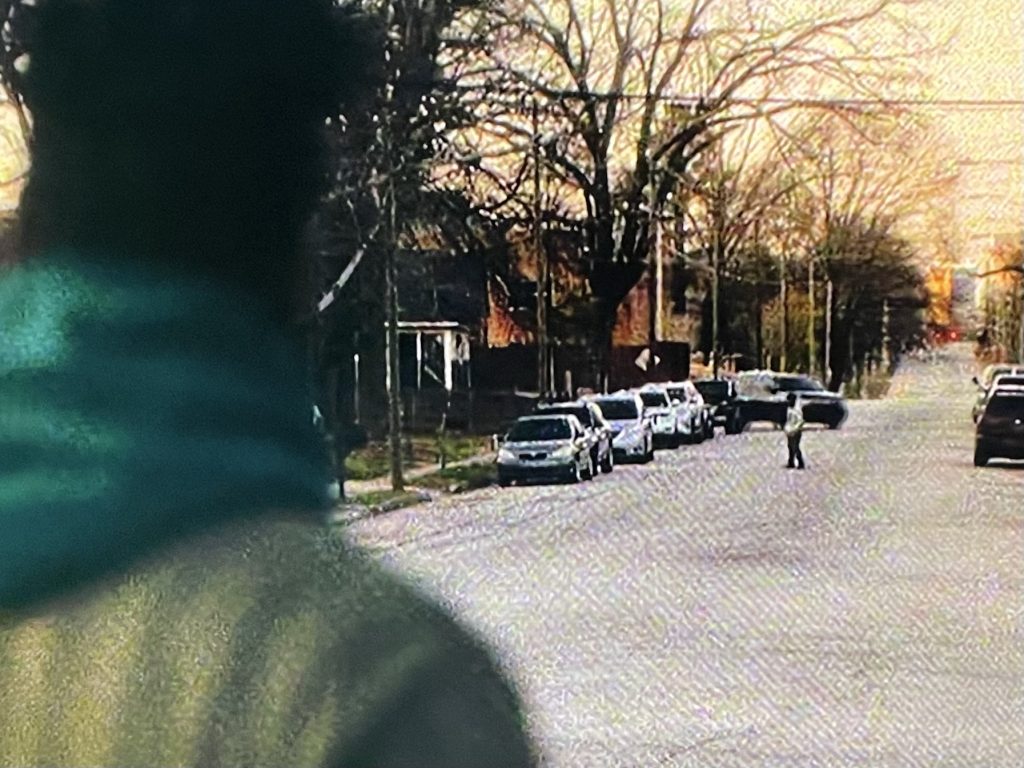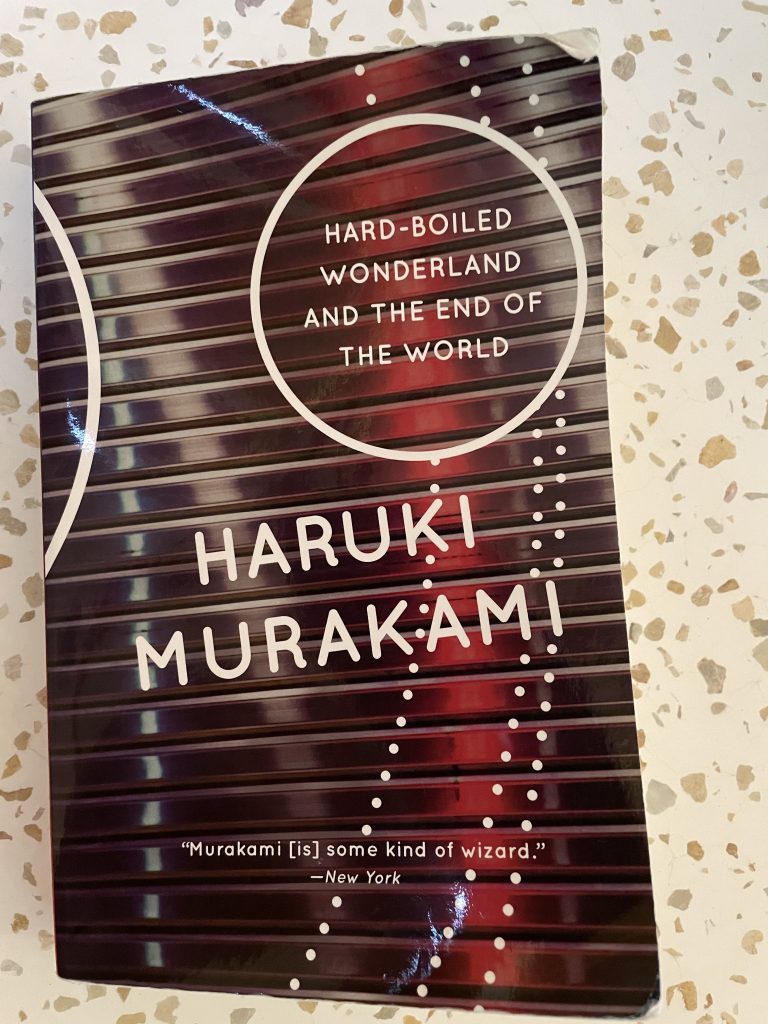Posts Tagged ‘no spoilers’
FEERSUM ENDJINN, A No-Spoiler Review
Iain M. Banks is a Scottish writer who produced literary and science fiction. He is a must read for all scifi fanatics. I only say this to the purists because if you are not a scifi purist, you might find Banks challenging. This is a review of FEERSUM ENDJINN, one of his scifi books. I have no idea if his lit fiction is easier to consume. That is not my genre. He wrote his literary fiction under the name: Iain Banks…without the “M” middle initial.
The Short Review
I recommend FEERSUM ENDJINN with reservations. Yes read for these reasons:
- If you want to gather the fathers and mothers of scifi into your knowledge base, you need to read Banks. Some would say, start with Consider Phlebas (the first novel of his Culture series). I will read that one next. Review will follow.
- Banks writes honestly in that he is someone who sees technology in his story as a power that infects every aspect of culture (will explain more in the longer review)
- You find a story thread in this novel that creates tension. The mystery is embedded in the story and characters and even the style of writing, but the reader has to work to figure out the narrative.
My reservations:
- Very little of the arc is made plain to the average reader, the story is a nut to crack. Not everyone wants to work that hard.
- 4 points of view give the narrative its shape, not all of those POVs are created equal
- One POV is told from the perspective of a creature, probably a bird of some type. It does not know traditional spelling so the reader will have to endure paragraphs that are confusing…reading sentences like this: That woz how we used 2 reech our hoam, 1 ov thi birdz tells me. The narration written in this form is about 1/6 of the book and it was very unpleasant for me to read…even though I knew Banks was doing something experimental and interesting. I wanted to like it, but didn’t.

The Longer Review:
FEERSUM ENDJINN is a story, rated PG or PG-13…Regarding the PG-13 rating, there is a reference to a character in bed with two women…and a couple of other random references to sexual desire that might deem the book PG-13…however, those references reveal character and were not given much airtime overall. For the most part, the characters are not interested in, or engaging with sex. Violence is also not prominent in this story.
The mystery lies in the future earth and in what form it is inhabited. Four characters give the sense of what this reality might be. Seemingly, Earth is really messed up. People are living underground and there is a battle between AI and a computer program that gives human beings their existence. I didn’t fully understand this dynamic from the text, but read a few articles to help me grasp the full meaning. The story was imaginative and made me wonder about the world, but overall…I found it difficult to connect with any of the characters. Maybe Gadfium (on of the POV characters), but ever he/she only sometimes evoked my empathy. I call Gadfium he/she because of the story world that brings characters back from death, but sometimes in male or female or even animal form.
A book that requires this much work to understand is not a joy for everyone. However, if you want to read the really nerdy people on Banks like Professor Joseph Heath you might begin to understand how groundbreaking was Banks’ vision of the future.
When I read Consider Phlebas later this year, I’ll comment on this more, I hope. For now…you have to read one Banks novel if you’re a fanatic and this one could be the one for you.
HOOD, by Stephen Lawhead, A No-Spoiler Review
Last fall, I needed to restock my Little Free Library, so headed to the local Goodwill to see what sci-fi, fantasy or dystopian fiction they had on hand. (My LFLibrary is filled with these genres only). I did find some great treasures, including this Stephen Lawhead book that I had never heard of. I began reading it sometime in the winter and got hooked. I knew of Lawhead because of reading the Pendragon Cycle sometime in my 20s. HOOD is book one in the King Raven Trilogy.
HOOD is the first book in a trilogy that follows a character based on the Robin Hood myth/legend.
Short Review of HOOD
I highly recommend this novel. Here’s why:
- Stephen Lawhead (author of The Pendragon Cycle…a version of the Arthurian Legend) is an accomplished writer who knows how to capture the voice of medieval and pre-medieval Brits.
- His world-building feels rooted in history, authentic
- The language engages…everything from the quirky colloquialisms, to the names of characters
- The characters are well developed, even the evil ones, and draw you into their world of struggle and heroism
- Woven into the story are Christian themes and prayers, which some won’t like, but I absorbed as authentic
- Rated PG (for medieval violence, think swords and bow and arrow…but no graphic sex or sexual violence)
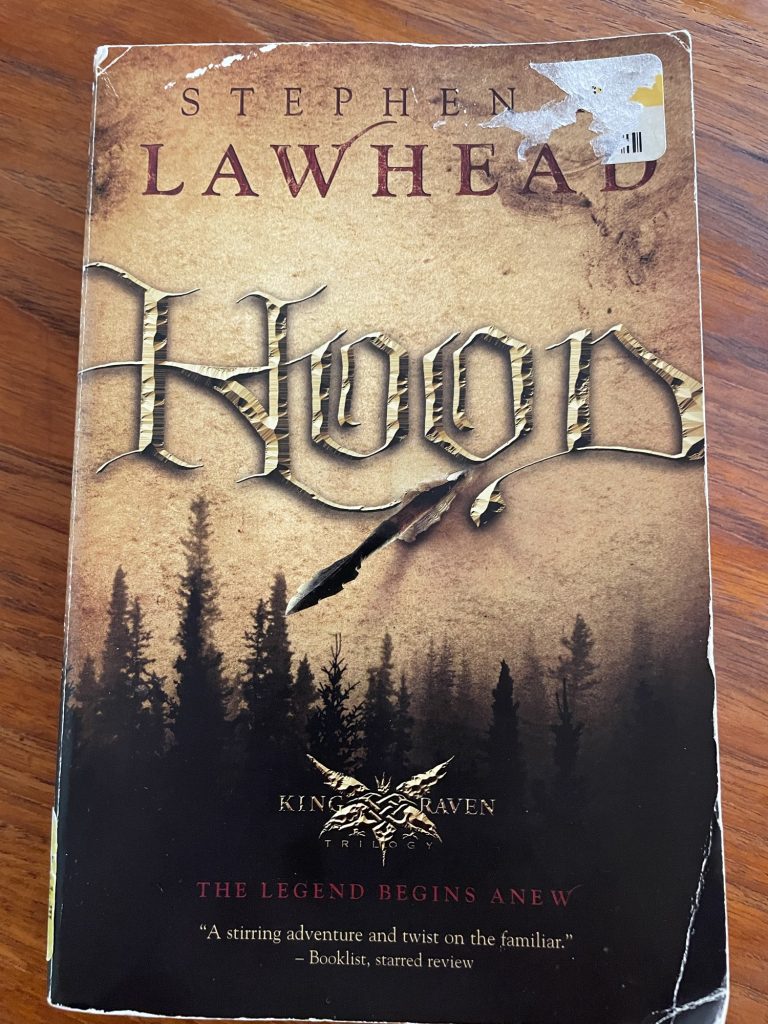
The Longer Review:
If you’re reading this novel, I recommend flipping to the back of the book and reading his essay: Robin Hood in Wales? It’s past the epilogue (don’t read the epilogue or you will spoil the story).
In this essay, Lawhead discusses why he sets HOOD in Wales, playing with the idea that the legend of Robin Hood had been around and circulating through the British Isles for a very long time before the general population associated him with Sherwood Forest. Here is a bit of that essay:
It will seem strange to many readers, and perhaps even perverse, to take Robin Hood out of Sherwood Forest and relocate him in Wales; worse still to remove all trace of Englishness, set his story in the eleventh century, and recast the honourable outlaw as an early British freedom fighter. My contention is that although in Nottingham, the Robin Hood legends found good soil in which to grow, they must surely have originated elsewhere.
The character we now know as Robin Hood can be traced as far back as the early 1260s. By 1350, the Robin Hood legends were well-known, if somewhat various, consisting of a loose aggregation of poems and songs plied by the troubadours and minstrels of the day. These poems and songs bore little relation to one another. The first written references to and carried titles such as “Robin Hood and the Potter,” “Robin Hood’s Chase,” “Robin Hood and the Bishop of Hereford,” “the Jolly Pinder of Wakefield,” The “Noble Fisherman,” “Robins Whood Turned Hermit”…
So, Lawhead poses the possibility that Robin Hood (or Rhi Bran Hud, as he is called by his Norman enemies) is a deposed Prince/King who is rallying his people to push back against the Norman Invasion? He fights a guerilla war with long bows and hides in the wild forests of the March, attacking and tormenting the French who cannot defeat this clever and courageous rival.
A comment about the Christian themes in this novel. The church and state are intermingled throughout Europe during this time in history. The Norman Kings are closely aligned with church. In 800 CE, Charlamagne is crowned by the pope as the Holy Roman Emperor. Kings are seen and dubbed as God’s holy vessels to lead the people. The church holds much power in this system and therefore becomes the vehicle for distributing blessing but also horrible injustice. Lawhead has been careful to look at source material as he weaves church and state together in his books. He also doesn’t sugarcoat the evil that was perpetrated by the church.
If you can enter into the world Lawhead has created and withhold judgment, realizing how different most of Europe was from the Post-Modern West, you can begin to understand something of the mindset of those who lived in this time period. Why did kings, for example, pay the church from their own treasury to atone for their sin of killing enemy soldiers and potentially damning them to hell? Why did priests go out with fighters to give them last rites before a battle? Reading Lawhead will put some of these questions into context. The link between the church and the king cannot be understated in a book that is attempting to portray authentic medieval culture.
Therefore, when I read HOOD I felt like I was reading historical fiction. It’s a kind of escape into fantasy, but not quite. Lawhead is so fluent in the language and history of this time period in Britain, that he transported me back a thousand years. This is an aspect of world-building that felt extremely enjoyable to me, which is why I recommend this book to readers of all ages.
THE FERRYMAN, A No-Spoiler Review of the Novel
Published in 2023 and still in hardback only, THE FERRYMAN, a novel by Justin Cronin, was a surprise find. My friend tipped me off. She is a serial reader, but normally reads lit fiction. She knows I read science fiction and speculative stuff. This book is science fiction and I’m not spoiling here. The first hint of a future/science fiction reality comes in the prologue. For the beginning half of the of the novel I was captured by the beauty of the writing. However, it’s always difficult to write a great ending, and THE FERRYMAN’s story/plot is complicated, very complicated and I’m not sure Cronin pulled it off.
First the Short Review: I Recommend THE FERRYMAN with Reservations
- Overall, lovely writing
- Suberb mystery and tension
- Interesting world-building
My Reservations:
- This is a long book, many words. Did it need to be this long?
- The last 1/3 of the book is a lot of explaining…the mysteries are not easily unwound and I’m still not sure I really get the ending
But still…it was a fun read. Here is one example of lovely writing in an early chapter:
“It came as a pleasant shock to me, how the man I’d known as a rather dry intellectual transformed himself so completely into a craftsman–a man who actually made things that the world could put to practical use Which only goes to show that people are more complicated than they let on and that even tragedy (sometimes only tragedy) can open the door to who we really are.”
This idea that tragedy opens up doors to identity is a theme that runs through the novel.

The Longer Review:
THE FERRYMAN’s setting is the fodder for much of the good writing. Prospera, a temperate island utopia, is home to a class of people known as Prosperans. Think Brave New World. Its inhabitants not only live and eat like royalty, they never die. In this world a technology exists that transfers the consciousness of an elder individual into a new body. Much of this process is surrounded in mystery because when the transfer takes place, memories are also wiped.
The new consciousness in a new body is in theory “the same person” being reborn, but without the baggage of memory. So is it really the same person? The reader wonders. For example, the main character, Proctor Bennet, dreams, and his dreams indicate a previous life, perhaps? Mysterious, though Prosperans are not supposed to dream. Something is amiss with Proctor Bennet.
Moreover, all is not well in Prospera. This becomes clear early in the story and drives much of the tension. There are other oddities in this world. Children with the re-inserted consciousness come from across the water on ferries at an older age, not as babies. All Prosperans have monitors inserted into their arms that measure their health and well-being. More importantly, an underclass of people perform the menial work on the island. These people have children naturally, live in a slum called the Annex, and do not seem to have access to the life-preserving technologies of the Prosperans. However, they make great art…an interesting discovery along the way, that those living in the Annex (as opposed to the Prosperans) live deeper lives, even though they are the underclass in society.
Proctor Bennet is a ferryman. He assists elders in the society who are ready to “end” their current lives. All this is done calmly, with signed contracts and quiet ceremony. When his own father is ready to board the ferry, Proctor is called and escorts his father to the ferry until his father unravels. A “scene” at the ferry is exactly what the Properans hate. Proctor’s experience around his father’s ugly departure across the sea thrusts him on a fact-finding mission. Clues emerge all around him. It’s around this section of the novel that I got the feeling there was glitch in the Matrix.
Except, the Matrix did the explaining soooo well. Maybe, this was because the Matrix was a film and not a novel. The backstory that unfolds in THE FERRYMAN is convoluted and complicated. The layers upon layers eventually are revealed, but the revelation felt forced to me, and so much less interesting than the setup. There was also a degree of cliche that felt disappointing to me. Same old, same old villains. Same old, same old catastrophe that set the thing in motion. All this is revealed by lots of explaining and lots of people having conversations with one another. Certainly, there needed to be some of this, but I felt there was too much. The style reminded me of Asimov, who loves to put two “smart” people (usually dominant white males) in a room together talking about and therefore telling the audience what’s going on. I’m not a fan of the style. So…those are my hangups. I think many will love this book. I know folks who adore Asimov for his ideas (if not his writing), but if I were you, I would maybe wait for the paperback, or pick up the audiobook…THE FERRYMAN could be fun to enjoy on a very very long road trip.
THEY CLONED TYRONE, A No-Spoiler Review
Tudum, Neflix’s official fan site, calls THEY CLONED TYRONE a gonzo sci-fi caper. I watched it with my son last week, a second time with my husband last night. Here’s my review. I enjoyed this caper at least as much the second time through. THEY CLONED TYRONE is rated R for violence, nudity and language. This film is streamable on Netflix.
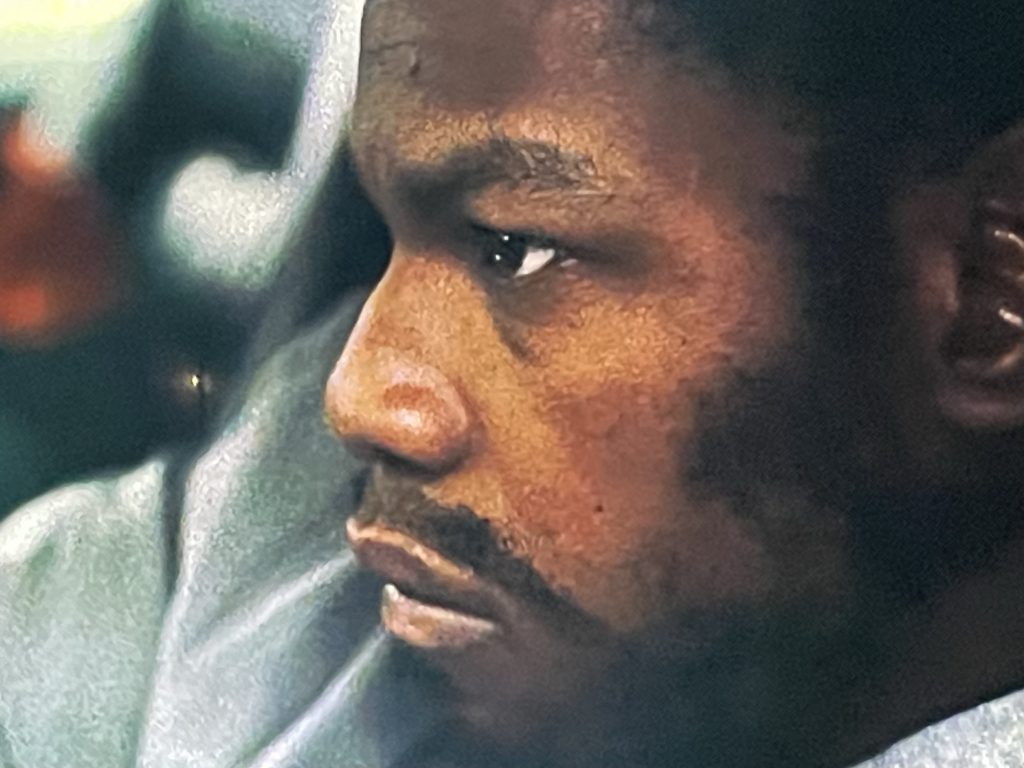
The Short Review
5 Reasons I recommend this film
- starring John Boyega, Jamie Foxx, Teyonah Parris, a fantastic trio, absolutely dynamic in all good ways
- authentic and gritty including design elements wonderfully contrasted in the 2 versions of “the Glen” portrayed
- a story that surprises…even knowing a clone is involved (see title), there are still some fantastic mysteries to solve
- THEY CLONED TYRONE was laugh-out-loud funny in parts, I found the dialogue and characters delightfully entertaining
- a serious social commentary worth contemplating
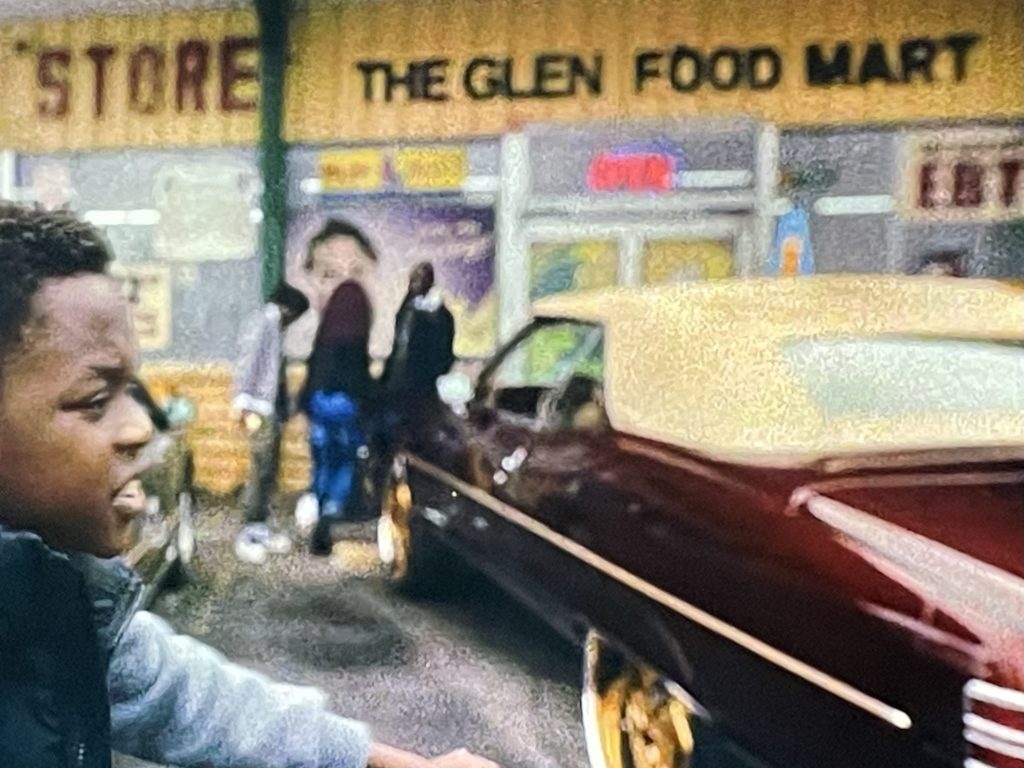
The Longer Review
When Jordan Peele decided to get into the film creation business and write/direct Get Out, Hollywood (and the general audience) sat up and took notice. Not only was Get Out entertaining in so many compelling ways, it was the fleshing out of an urban myth that a racially charged society like the US understood, even feared. Peele broke the mold with Get Out and then deepened his creative impact with Nope and Us, paving the way for creators like Juel Taylor. Taylor wrote and directed THEY CLONED TYRONE.
One of the things I loved about THEY CLONED TYRONE is that the narrative puts forward an allegorical reality in which systemic racism can be discussed in the real world. Moreover, it does this in an entertaining and thoughtful way. There is a scene early on, a face-off between the Slick, played by Jamie Foxx, and Fontaine, played by John Boyega, where Slick expresses his frustration about black on black violence in The Glen (the story’s setting–a poor black neighborhood of unknown location). To hear the phrase black on black violence verbalized in a narrative by a black character from the hood is a bold move by the filmmaker. He has to know that this idea has been taken up and championed by many conservative politicians, but rarely with appropriate context and compassion. However, when the Foxx character says it, I felt the sadness of the filmmaker’s commentary. It felt appropriately like a cry into the void.
Taylor didn’t overplay his hand with that line, but did leave the phrase vibrating throughout the rest of the narrative. By the finale of the film, the idea is turned upside down. I hesitate to say more because *spoilers*, but there are so many good questions posed in this film, I might just have to watch it a third time.
HARD-BOILED WONDERLAND AND THE END OF THE WORLD. A No-Spoiler Review
Murakami. Ah Murakami.
I took up this science fiction novel because having read so much mainstream scifi in the last few years, I found myself pining for beautiful prose. Haruki Murakami did not disappoint and HARD-BOILED WONDERLAND AND THE END OF THE WORLD is not only an imaginative story that passes the muster of science fiction, but had me laughing out loud at various points.
This story is rated R for sexual content.
First, the short review.

6 Reasons I recommend HARD-BOILED
- Masterful storytelling, including a full-blown mystery embedded in the structure of the novel
- Beautifully drawn characters who not only feel true, but are likeable in their quirkiness
- An imaginative world where scifi touches magic realism
- Humor
- Gorgeous prose and great writing in general
- Unicorns
2 Reasons to Avoid HARD-BOILED
- If you only read sciency science fiction and could care less about prose…this book might not be for you
- If you need a straight-forward ending, this story does not have that
The Longer Review
Step into the world of Murakami, his imagination and his Japanese way of looking at life. In this novel, he alternates point of view chapter by chapter. He does not explain how the two POV’s are connected until close to the end. Both storylines are told in first person. Both protagonists are male in midlife. His easy prose and everyman protagonist give the fictional world not just shape and beauty, but allow for emotional access. This hero is not someone extraordinary and with super powers. He is any one of us caught in a dilemma. The story meanders through a Tokyo imagined, not exactly futuristic on the surface. People drive cars, listen to Bob Dylan cassette tapes, and drink Miller High Life, but the city is run by two rival factions, the Factory and the System. A third group, the INKlings, folktale creatures that rule an underground society, live beneath the city. One character summarizes this way:
“Is Japan a total monopoly state or what? The System monopolizes everything under the info sun, the Factory monopolizes everything in the shadows. They don’t know the meaning of competition.”
“Inklings? A sharp guy like you don’t know about Inkling? A.k.a. infra-Nocturnal kappa. You thought kappa were folktales? They live underground. They hole up in the subways and sewers, eat the city’s garbage, and drink graywater. They don’t bother with human beings. Except for a few subway workmen who disappear, that is, he he.”
As for Murakami’s prose, an excerpt:
Something has summoned me here. Something intractable. And for this, I have forfeited my shadow and my memory. The River murmurs at my feet. There is the sandbar midstream, and on it the willows sway as they trail their long branches in the current. The water is beautifully clear. I can see fish playing among the rocks. Gazing at the River soothes me. Steps lead down from the bridge to the sandbar. A bend waits under the willows, a few beasts lay nearby. Often have I descended to the sandbar and offered crusts of bread to the beasts. At first they hesitated, but now the old and the very young eat from my hand. As the autumn deepens, the fathomless lakes of their eyes assume an ever more sorrowful hue. The leaves turn color, the grasses wither; the beasts sense the advance of a long hungry season and bowing to their vision, I too know a sadness.
Ah, Murakami and the magic of his prose.
THE OA. A No-spoiler Review
On NETFLIX’s suggestion, I started watching THE OA. I should research shows before I start, because after watching season one, I looked online and saw that the series was canceled after two seasons. The story had been intended for five. The first episode aired in 2016, so a while ago! THE OA was written by acclaimed Iranian filmmaker, Zal Batmanglij and Brit Marling. who also stars as the main character, Prairie Johhnson.
THE OA, streamable on Netflix is a scifi-paranormal story set in suburban Michigan (mostly). I’ve watched the first season so far…THE OA is rated R for nudity and though it is a minimal amount of sexual content, it is full frontal nudity. With that said, this story potentially appeals to the young adult audience. Many of the characters are in high school or in their early twenties.

First, the Short Review…
4 Reasons to Watch
- THE OA draws the audience in through character(s) and builds tension through mystery
- A number of interesting and atypical characters
- THE OA explores the intersection of the metaphysical and the spiritual by focusing on life after death
- There is a fairytale-like quality to the storytelling that many will appreciate
2 Reasons to Skip
- THE OA was canceled after two seasons. The writers had envisioned 5, so it ends on a cliffhanger
- This story tries to tackle “a story within a story” and is mostly well-done, but feels forced at times
The Longer Review…
There is much to appreciate about an ambitious story like THE OA that attempts to unearth human longing for the spiritual. I found THE OA to be gripping in how it asks questions about redemption while exploring the role of miracles in that redemption. However, the exploration is unsatisfactory when the overall story gets cut off by a platform like Netflix. The story arc was written for five seasons, the viewer only got 2. I call this phenomena, the Firefly conundrum, named after the much acclaimed scifi series, Firefly, whose cancellation was pre-streaming service.
Similar to THE OA’s cancellation, Firefly’s production was halted due to not enough eyeballs watching or what the television industry then called low “Nielsen ratings”. The show’s devoted fans were anywhere from perplexed to enraged by this cancellation, but what can you do? Ironically, interest in the series surged even as it was cancelled such that when it went to DVD, sales were so good, the producers realized they had made a mistake.
It was too late to go back and recreate all those episodes. Instead, the film Serenity was the attempt to bring the story to a close. Diehard fans felt that if the Fox network had been willing to take that extra risk and continue making episodes, Firefly might have become a franchise on par with Battle Star Galactica or even Star Trek.
Netflix is not the first or the only platform that cancels shows midstream, but I wonder if their current business model, where they suggest shows to people like me knowing the story has been truncated, creates bitterness in its subscribers. It’s like they keep loaning me novels and then stealing them away when I’m part way through. Pretty soon, I stop taking novels from them and become more careful. In the worst case, people like me leave Netflix until they decide there is a show ready in its entirety, then subscribe for a time. Or, subscribers take fewer risks and reject watching new/untested productions which means fewer of these interesting and new stories get made.
In this scenario, the indie film people, the new and fresh storytellers suffer as do those hungry for something different. The audience gets more of the same old ideas and drivel, that which is tried and tested, but not necessarily exciting and experimental. It is the age-old question about the arts and profit. Profit is a reality in Hollywood. Netflix does have to pay its bills (and shareholders), but taking fewer risks in stories means I’m more likely to stop subscribing at some point. I haven’t gotten there yet, but I might.

RED MARS, by Kim Stanley Robinson, A No-Spoiler Review of the Classic Scifi Novel
The Short Review
5 reasons RED MARS is a must-read for the scifi fanatic and anyone remotely interested in planetary geology:
- RED MARS is a KSRobinson classic, published in 1992 and winner of the Nebula and the first of his acclaimed Mars Trilogy
- The story imagines life on Mars in a way that feels scientifically viable and compelling, therefore relevant to the current and growing conversation around Mars exploration
- Scientists are the narrators of this story. They are also the heroes, sometimes the villains, the problem solvers and the work horses. I was especially drawn to the “builder” character, Nadia
- The planetary geology content, naturally integrated into the story, is breathtakingly fun
- Despite being over 170K words long, KSR does not get bogged down in the “how would that ever be possible” science scenarios, but drives the story forward through characters and the politics that pressure a budding Martian community
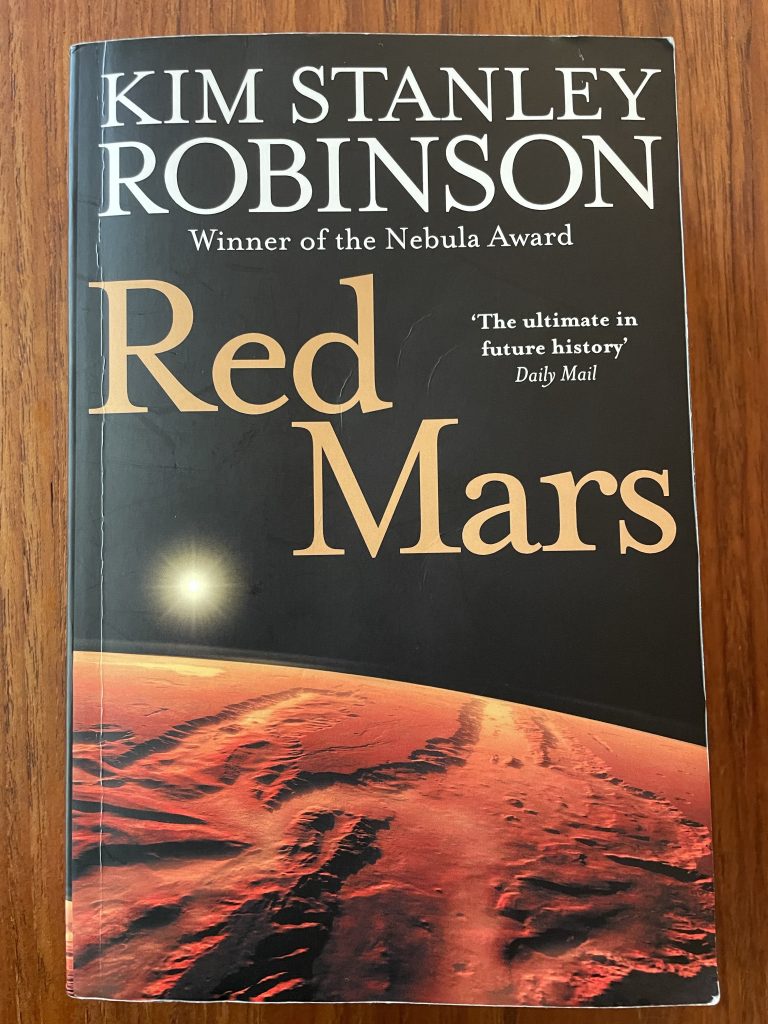
The Longer Review
RED MARS tells the story of the first 100 scientists sent to Mars by a multi-national Earth entity called UNOMA, United Nations of Martian Affairs. The story PG-13 (for some sexual content) follows about 10 of those scientists closely, though many others are referred to and are part of the action in direct and indirect ways. The novel is broken up into eight parts and each of the parts has a different primary narrator. I do think Robinson’s choice on point of view works in a novel this long, adding a level of complexity and depth to the very audacious idea that Mars might be “tamed” by human beings. Robinson plays with themes around the idea that really smart people might be able to build a better civilization from scratch, and form some kind of utopia, but does not make the task easy on the idealogues within his story.
Various characters, all of whom are scientists in one discipline or another, give voice to ideas of alternative governing and living environments. The sharing of abundant resources is the initial reality for the first 100, but eventually, when new groups arrive on Mars, the corporations who have funded the exploration and building, come calling for the planet’s vast natural resources.
The conflict that arises is somewhat predictable and draws out the best and worst of the people in charge who are trying to manage a fragile, but quickly expanding human presence on Mars.
Meanwhile, Earth is falling into total chaos. Robinson does not spend any time showing the reader Earth itself, but shows it via news stories viewed by the inhabitants of Mars. Earth’s chaos is also a reason why many thousands of migrants are streaming to the new world. Robinson does lean left in his politics (proudly so) and sees corporate giants as the villain, though the villain is also amorphous in the story. Robinson’s ideas don’t come across as preachy to me. He’s a deep thinker and a thoughtful writer, so he understands the grittiness of governing and the probable impossibility of building that utopia even if one does start with 100 brilliant scientists.
Many science fiction readers will not mind the length of RED MARS, but at times, I confess to being a bit bored and wondered…Where is this story going? However, I did stick it out and the payoff was decent. It stands alone as a novel, without the kind of cliffhangers that drive you to the second book. Will I read the next two books in the trilogy? Probably yes, but not this summer.
1899, A No-spoiler Review
If you liked the television series LOST and you’re a fan of Baran bo Odar and Jantje Friese (creators of DARK) you will want to log into to your Netflix account and start streaming 1899 now. With that said, I give warning, a second season was not renewed. For some, this will be a reason not to watch. However, I wonder if buzz about the show might result in the approval of a second season. I hope so because I really want to understand this world that falls into the category of mystery/paranormal/science fiction.
First, the short review
4 Reasons to Watch the series, 1899
- Excellent production overall, with creepy settings and period costumes
- Well-acted by a diversity of performers, many of whom are new to the American audience, though a few starred in DARK
- Lots of tension and mystery
- Claustrophobic and isolating setting. Ocean-going vessel all alone on the open seas (well…sort of alone)
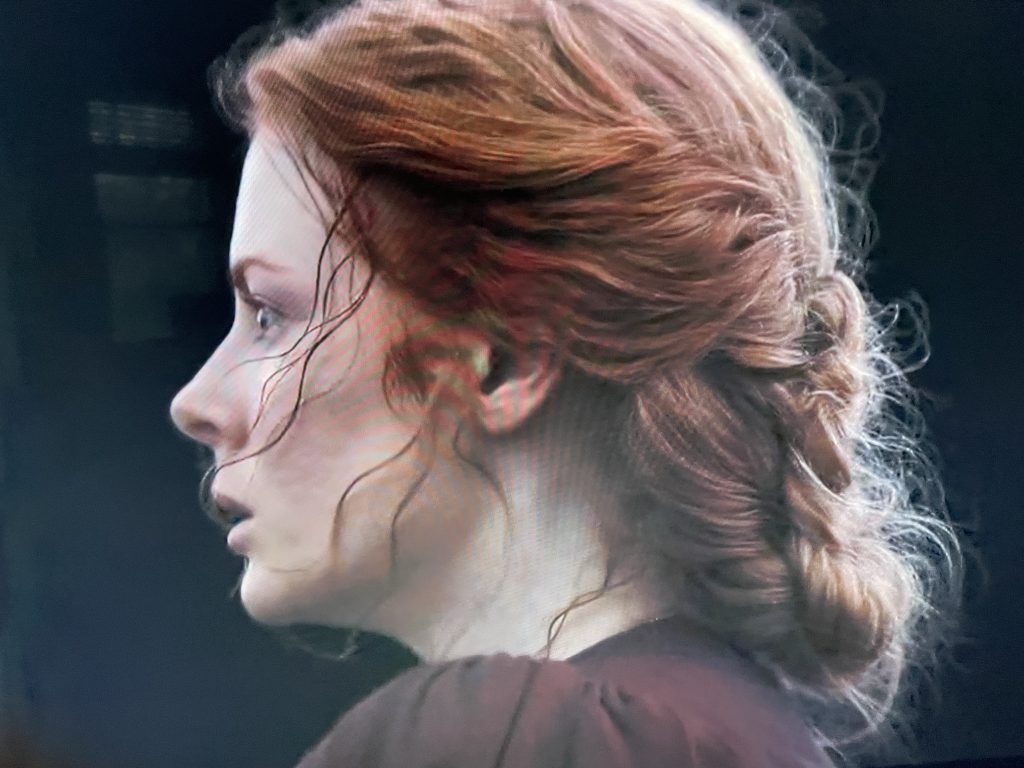
A Longer Review
1899 is free to Netflix subscribers. Eight episodes make up the first season. I rate it R for sexual content and some violence.
Baran bo Odar and Jantje Friese bring to the screen this mind-twisting mystery with a style that broods and draws in its audience. That style will be familiar to fans of Odar and Friese’s imaginative work in the time-travel story, DARK.
1899 opens with the main character, Maura Franklin-Singleton, played by Emily Beecham, waking from a nightmare. The viewer quickly learns that Maura is living in another century. The title of the series is a helpful reference point as are the period costumes. Maura is also aboard an ocean liner with hundreds of other passengers, on its way to America from Europe. She appears to be traveling alone.

From the first moment of the longer narrative arc, confusion about reality is introduced to the viewer through the character of Maura. Her nightmare before waking is a terrifying scene in what seems to be a sanitorium for the mentally ill. She is strapped into a chair and given an injection while the command WAKE UP jolts her out of sleep and into the “real” world. The audience, along with Maura, sense the nightmare holds a degree of reality as she views the red marks on her wrists, where in the nightmare, she was strapped to the chair. She quickly covers those up with her long, victorian sleeves, and heads to the ship’s upper-class dining hall. To add drama to this ship’s community at large, there is a large portion of underclass people living below deck for the duration of the cruise.
Waking from a dream becomes a thread throughout the story as other characters, some of her fellow travelers, experience dreaming and waking to the same command, WAKE UP. The stories of these characters are slowly woven together into a climax that truly surprises.
OKJA, Your Next Family Movie Night? My No-Spoiler Review
OKJA, directed by Bong Joon-ho, written by Joon-ho and Jon Ronson (from a story by Joon-ho) is yet another example of Korean film genius. This film is set in a speculative future (despite the film’s timestamp of 2007)…the scifi aspects of the story have to do with genetics. First, the short review.
6 Reasons OKJA Will Delight
- Streamable for free on Netflix, family friendly (I would rate it PG-13 for violence)
- Although there are Korean characters who only speak Korean (therefore, yes, you’ll have to read subtitles), much of this film is either visual narrative or the characters speak English
- Action-packed
- Funny and Heart-warming (the creature created for this film is cute and compelling)
- Thoughtful perspective on the food industrial complex
- With the child protagonist on a grand chase/adventure and with compassion at its core, this story feels like Studio Ghibli in all the best ways

Longer Review
Lately, when I look for something interesting and fun to watch, I gravitate toward Korean filmmakers. Why? They are some of the best storytellers around and Netflix is committed to working with them/putting their work out to the broadest audience. Moreover, Korean filmmakers don’t seem fixated on US/European political issues, which bore me these days. OKJA does touch on the industrial food complex…a global reality that is political. In particular, OKJA explores how meat is produced and processed for broad human consumption. But don’t let that stop you from watching this interesting and entertaining film. I think the questions that arise from the film are worth thinking about for every person on Earth, whether a vegetarian, vegan, or an omnivore. Kids watching this will also feel the implications of our “appetites”. It’s not a bad thing to help our youth understand that meat actually comes from creatures who live on this Earth with and among us. That’s a worthy conversation to have with our future leaders who will likely make choices for all of us about how we are to care for planet and creatures.

With an all-star cast, both Korean and US born actors inhabit this film. Stars like Tilda Swinton, Steven Yuen (The Walking Dead, Minari, Nope), Paul Dano (Little Miss Sunshine, The Batman, The Fabelmans), Yoon Je-moon (The Man Nextdoor), and Jake Gyllenhaal (Nightcrawler, Donny Darko) inhabit this universe. The protagonist, Korean actress Ahn Seo-hyun, is fantastic as the stoic caretaker of OKJA. She is the studio Ghibli-styled determined child who will not give up on her friend. This story is as much about loyalty and friendship as it is about food politics. I loved OKJA and I hope your family does too.

THE LAST OF US, A No-Spoiler Review of the First 3 Episodes
THE LAST OF US, an HBO Max series is streaming now, but the release of episodes is drip…drip…The third installment arrived on Sunday (1/29/23) and now, like old fashioned tv watching, the audience waits a week, and so on. It’s an interesting choice that some streaming services have made, to hook viewers over a long period and keep them paying the monthly streaming charge. Does it work? I’ll comment more on that in the longer review.
If you’re a gamer, you probably know that the heart of this story is based on the video game, The Last of Us, an action-adventure survival horror game franchise created by Naughty Dog and Sony Interactive Entertainment. The series is set in a post-apocalyptic United States ravaged by cannibalistic creatures infected by a mutated fungus in the genus Cordyceps. The game is rated R for violence and some sexually explicit scenes. At this point, 3 episodes in, the series is probably between a PG-13 and R rating, for violence.
For Educators: In biology class, give the gamers among you a treat by validating their hobby and teaching a lesson at the same time. Show the first 2 episodes (that’s all you’ll need) to discuss the nature of a fungus.

Is THE LAST OF US worth watching and perhaps more importantly, would you pay for an HBO subscription for this series alone? I recommend this series, with reservations. Short and long no-spoiler reviews will explain why.
The Short Review…Yes, watch
- If you love end-of-the-world zombie stories, this one has a couple of new twists to love
- Cool monsters and fast unlike the mostly ambling creatures in The Walking Dead
- Well casted (also, actors with talent that aren’t in every other show you’ve seen)
- If you play this game/love this game…it’s a new and perhaps fun way to interact with the world
The Short Review…Meh…don’t watch, or perhaps it’s too early to tell
- Overall and so far, this story feels less compelling than The Walking Dead or even Cormac McCarthy’s novel The Road, which I just finished reading. You’re better off spending your time reading or watching something else.
- Beware of attaching to key characters because the chances of them dying are really high (for many viewers, I realize this is a plus)
- In episode 3, spent a lot of time with a couple of characters who seemed peripheral to the heart of the story. If more episodes are like this one, not sure if I’ll want to keep watching
- Lastly, this series alone would not warrant paying for an HBO Max subscription. However, overall HBO content for science fiction, fantasy and dystopian viewing is decent. For example, you can stream DUNE Pt 1 and I loved Station Eleven, a mini-series based on the novel. Click to read my review of Station Eleven. Those are just a couple of examples of HBO’s excellent content.
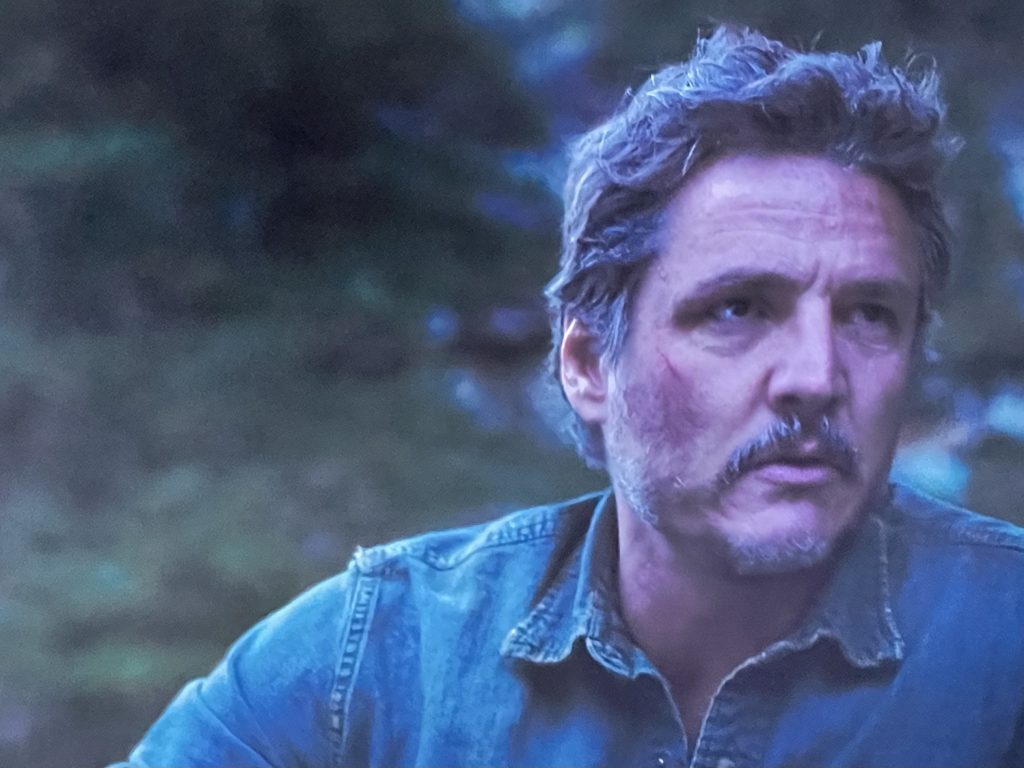
The Longer Review
The Last of Us game in numerous iterations, has received critical acclaim and has won awards, including several Game of the Year recognitions. As of January 2023, the franchise has sold over 37 million games worldwide. Strong sales and support of the series led to the franchise’s expansion into other media, including a comic book in 2013 and this television adaptation. So…there is a built-in audience for the series, THE LAST OF US.
That’s a good thing for HBO, but from game to screen…has it ever been done well? I’m not an expert on this one, but I can’t think of a really great film or series that emerged from a game. Pretty good or fun shows…like Tomb Raider…those I could cite, but great? I don’t think so. Does anyone want to counter me here? This series has potential to say something new about the post-virus world, or in this case, post-fungus world (not a spoiler by the way…scene 1 of the series shows a scientist surmising about what would happen if a certain type of fungus evolved and could take over the human brain/body.)
In three episodes, the viewer gets a sense of one post-apocalyptic region in the US, an area around Boston. There is an allusion in episode 1 and 2 to world-wide catastrophe. There is a huge time jump between 1 and 2. The outbreak takes place in 2003 in episode 1. The rest of the series looks like it will take place 20 years later in 2023, with flashbacks to fill in the gaps here and there. The fungus shows up first in Jakarta, Indonesia…but we learn in episode 3 that the fungus probably went global simultaneously because it was in the food supply, in something like flour or sugar. That idea is unique, moveover, the zombies are weird and fast and hard to kill (bullet to the brain seems to do the job, similar to other zombie narratives). The fungus infested monsters are portrayed in a fuller way in episode 2.

In the era of binge watching, it’s possible a series such as THE LAST OF US will draw in fresh consumers to HBO streaming, but my guess is it won’t. The buzz that drives everyone to want to watch Stranger Things, because of the “event” of binging the entire season and sharing that experience with millions of fans, that is absent from the HBO and other streaming services’ business model. FoMO associated with binge watching fuels the marketing machine for Netflix. Millions are driven to want a subscription. Some buy, maybe thinking they’ll pay for a short time, and wind up staying longer or forever. Others do pay for one month and then quit…which is better for Netflix than those who use or steal a password to get their fix.
I am feeling a little frustrated by the drip…drip model. I don’t binge all in one day, but I like to watch the same show night after night. I hate waiting a week. It’s probable I will lose interest or get fixated on another show. I can’t be alone on that. So, if you’re a binge watcher and you think you might like this series, you might wanna wait for another couple of months so you’ll have more content. Subscribe to HBOMax in May, an you’ll have a whole lot of Game of Thrones: House of the Dragon and perhaps the first season of THE LAST OF US

